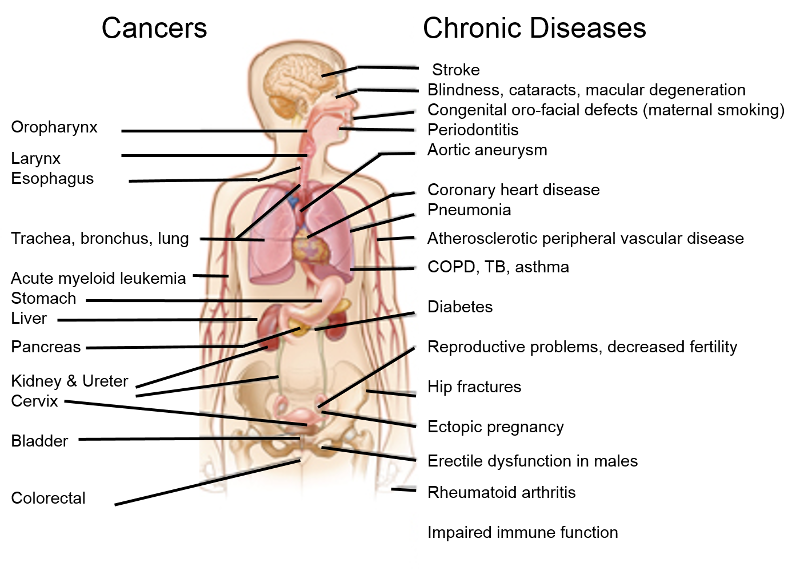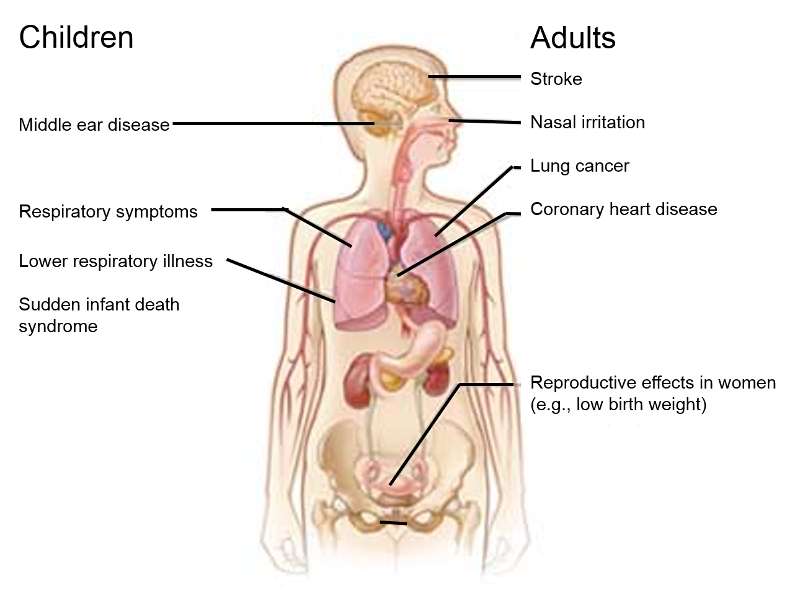Effects of Smoking
Tobacco smoke is a complex mixture of toxic and carcinogenic chemicals and particulate matter. A review article by Talhout et al. (Int J Environ Res Public Health. Feb 2011; 8(2): 613–628.) concluded that emission levels of 98 components in mainstream smoke constituted a human inhalation risk with the potential to contribute to the many established adverse health effects associated with smoking.
Premature Death
The CDC web page on Health Effects of Cigarette Smoking states that
- Smoking is the leading preventable cause of death in the United States
- More than 480,000 deaths per year in the US can be attributed to cigarette smoking (note that this is not a precise estimate, since it includes all of the smoking related events listed in the table below).
- Smoking causes about 90% of lung cancer deaths in men and women. More women die from lung cancer each year than from breast cancer.
- About 50-80% of all deaths from chronic obstructive pulmonary disease (COPD) are caused by smoking.
Table - Premature Deaths Caused by Smoking and Exposure to Secondhand Smoke from 1965 to 2014
|
Cause of Death |
Total Number |
|---|---|
|
Smoking-related cancers |
6,587,000 |
|
Cardiovascular and metabolic diseases |
7,787,000 |
|
Pulmonary disease |
3,804,000 |
|
Conditions related to pregnancy and birth |
108,000 |
|
Residential fires |
86,000 |
|
Lung cancers from exposure to secondhand smoke |
263,000 |
|
Coronary heart disease from secondhand smoke |
2,194,000 |
|
TOTAL |
20,830,000 |
Source: CDC, National Center for Chroic Disease Prevention and Health Promotion, Office on Smoking and Health.
Modified from the Executive Summary of The Health Consequences of Smoking - 50 Years of Progress:
A Report of the Surgeon General, U.S. Department of Health and Human Services, 2014
Cardiovascular Disease
Regular smoking has the following effects:
- Generates free radicals that damage tissue membranes
- Increases blood pressure
- Increases blood clotting
- Promotes atherosclerosis
- Causes 2-4 fold Increased risk of coronary heart disease
- Causes 2-4 fold increased risk of stroke
- Causes 2-4 fold increased risk of peripheral vascular disease (atherosclerotic occlusions in carotid arteries, aorta, and arteries supplying the abdominal organs, kidneys, and lower extremities
Respiratory Disease
- Regular smokers have a 12-fold increased risk of disability and death from chronic obstructive pulmonary disease (COPD). Smoking accounts for 80-90% of deaths from COPD.
- Tobacco smoke can trigger asthmatics attacks in smokers and non-smokers
- Smoking is by far the leading cause of lung cancer; heavy smokers have about a 20-fold increase in risk.
Cancer
Tobacco smoke contains a number of established carcinogens, and smoking is associated with an increased risk of cancer throughout the body, including:
Smoking can cause cancer almost anywhere in your body:
- Bladder
- Blood (acute myeloid leukemia)
- Cervix
- Colon and rectum (colorectal)
- Esophagus
- Kidney and ureter
- Larynx
- Liver
- Oropharynx (includes parts of the throat, tongue, soft palate, and the tonsils)
- Pancreas
- Stomach
- Trachea, bronchus, and lung
For more information on the causes of cancer, see the online learning module on The Biology of Cancer. Page 5 of the module focuses specifically on the evolution of lung cancer.
Reproductive Problems
Smoking decreases fertility in women and men, and women who smoke during pregnancy have an increased risk of the following::
- Pre-term (early) delivery
- Stillbirth (death of the baby before birth)
- Low birth weight
- Sudden infant death syndrome
 (known as SIDS or crib death)
(known as SIDS or crib death) - Ectopic pregnancy

- Orofacial cleft

Decreased Bone Density
Postmenopausal women who smoke have lower bone density and increased risk of hip fracture compared to women who never smoked.
Effects of Active Smoking

Adapted from http://www.cdc.gov/tobacco/data_statistics/fact_sheets/health_effects/effects_cig_smoking/
Effects of Environmental Tobacco Smoke

Adapted from http://www.cdc.gov/tobacco/data_statistics/fact_sheets/health_effects/effects_cig_smoking/


